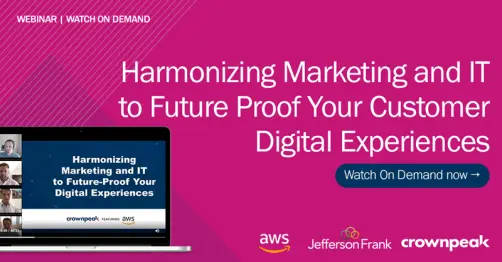The Future is Composable: What Technology and Recruitment Trends Reveal

Three key takeaways from our webinar with Amazon Web Services (AWS) and Jefferson Frank.
Marketing departments are the largest line of business in terms of technology purchases today, and Forrester estimates that Chief Marketing Officers will spend over $122B on marketing technology and services by 2022, explains Brian Stavis, Global Category Lead at Amazon Web Services in our webinar: Harmonizing Marketing and IT to Future-Proof Your Digital Experiences.
A lot of factors are playing into this, including the ever-expanding array of new channels available to omnichannel marketers, the growth in 5G and the enablement of more IoT devices, new technologies like AI and machine learning that provide enhanced intelligence for strategic decision-making as well as personalization, and the industry-wide acceleration of digital transformation initiatives catalyzed by the pandemic.
Marketing/IT friction slows things down
With all of this digital transformation, it's no wonder that marketing and IT are joined at the hip more than ever before. And when each department has their own agenda, there's bound to be some friction. We worked with independent research firm Vanson Bourne to survey 400 IT and marketing decision-makers about their digital experiences, and their responses revealed the depth of those challenges:
93% of those surveyed said that speed and agility are either extremely or very important to their organization when delivering digital experiences and managing their online content.Nearly all respondents’ organizations (97%), reported a reliance from the marketing department on the IT department.
Yet…
82% of marketers reported that having to wait for IT when working on new digital experiences is one of the most likely causes to delay marketing business impact. And IT reported that they spend more than half of their time (55%) maintaining existing experiences instead of creating new ones.
When marketing and IT are not working together effectively, the friction is palpable, and so is the cost to the organizations they work for. On average, respondents said they believe they would see a 38% uplift in revenue with their organization if they could make improvements in this area.
It’s nobody’s fault
In fact, everyone is just doing their job. For IT, that is to build and maintain safe, secure and scalable platforms. That's not something one can dash together quickly. And for marketers, in order to drive top-line growth, the key to success is agility – the ability to quickly respond to changing market needs and to engage with customers across an ever-growing number of channels.
When IT can't support that, marketers simply go around IT, employing agencies to do the work for them, and often ending up with multiple CMSs that don't work together. Eventually, this siloed approach leads to higher costs, more work and less security – how do you maintain updates and ensure compliance across such a varied digital landscape? Crownpeak's Paul Taylor, also featured in the webinar, explains this in more detail in his blog Why marketing goes rogue: 5 causes of CMS sprawl.
Compose the right team with technology + people
For organizations to unlock their digital marketing potential and seize a strategic advantage, they must look closely at how well they are bridging this marketing-IT divide – both in terms of technology and people. Here are three steps to get things moving in the right direction.
1. Remove roadblocks to agility
The first step is to review your current technology platforms and identify possible roadblocks to agility. How effectively is your organization making the shift to omnichannel marketing? How are you responding to today's technology trends – from the explosion of martec solutions (more than 8,000 vendors and counting) to new technologies like IoT and AI? How are you ensuring compliance and accessibility across every channel? Is it consistent? Are there dangerous gaps that could hurt your company socially or in terms of security? How interoperable is your martec stack? Is it a monolith that makes agility a bigger challenge or a collection of best-of-breed solutions? Is it forcing both your marketing and IT departments to dangerously hop from silo to silo? Or is it a well-oiled machine that offers composability with the advantages of a single platform to manage all your digital experiences?
This is the realm where best-of-breed technologies are enabling companies to tailor their tech stacks precisely and adapt at the speed of the market. But if those technologies are all over the map, with no underlying interoperability or architecture, it's not efficient. It's impossible for marketing to have a strategic view across every channel and it's a nightmare for IT to deploy and maintain (which, in turn, slows down marketing’s ability to deliver at speed and scale). And, in this world where security has never been more essential and compliance is a global requirement, a lack of cohesion and interoperability is actually a threat.
2. Compose your technology
A composable Digital Experience Platform (DXP) has an architecture that allows enterprises to pick and choose the best-of-breed capabilities they need within an ecosystem of connected technologies – an approach that allows them to continually re-evaluate their stack as the market shifts direction, says Paul Tayler, Crownpeak Vice President, Solutions Engineering.
The analyst community is also validating this paradigm by shifting their focus from packaged DXP to a more component-oriented one, as described by Gartner with their “ Composable DXP ” and Forrester with their “Agile CMS” approaches where DXP involves several connected vendors working together in harmony.
A composable DXP, like Crownpeak, brings it all together. Best-of-breed capabilities – including hybrid headless CMS, personalization, digital quality and accessibility and privacy and consent compliance – work together seamlessly, enabling marketers to orchestrate and quickly deploy high-impact digital experiences across a multitude of channels without having to go to IT at every turn. And because the platform and all the component technologies are what we call “True SaaS”, security updates and new features are automatically applied across the stack. Time for IT to breathe a sigh of relief.
3. Compose your team
The third key element to bridging the marketing-IT gap is people. Here’s where the webinar takes this to a new level with Clifford Myatt, Senior Vice President at recruiting firm Jefferson Frank.
Digital transformation, along with the proliferation of new technologies and the shift of buying power into marketing departments, is having a dramatic effect on how marketing teams are composed and staffed. It has created an array of new, blended roles that bring new skillsets into the marketing department, such as data analysts who know how to use AI and machine learning to help drive strategic decisions and experts in IoT and mobile.
Another area of tremendous growth is security, Myatt says. While this has been one of the most popular trends in recent years, the pandemic made it a top priority, and, according to Myatt, the number of cybersecurity jobs is growing three times faster than other tech jobs.
So how are organizations handling this shift in terms of their hiring? As with their technology, they also need to compose a team that has multiple skill sets that help bridge across marketing and IT functions. The hardest part is that today’s market is seeing the power shift to the job seekers, and employers are competing for candidates with the expertise they need.
Myatt says that companies who are getting ahead of this aren’t looking for the perfect fit for every position, but rather looking for people who have a combination of technical and interpersonal skills. They’re looking for people who have the ability to communicate well and who demonstrate the desire to learn and grow rather than siloed experts. This ensures that the organization is more agile and able to respond to ever-changing needs across marketing and technology.
Among the many skillsets companies are looking for, people who understand and have an aptitude for using AI and ML tools – from chatbots to personalized customer experiences and recommendations to programmatic advertising and content creation. And, he noted, AI positions are already some of the highest paying jobs out there right now.
When you have the right composition of technology and people – empowered to perform at their best – your enterprise can respond more quickly to change; orchestrate engaging, personalized digital experiences that delight your customers; and create an agile, future-proof organization.
Access the full webinar on demand now: Harmonizing Marketing and IT to Future-Proof Your Digital Experiences
